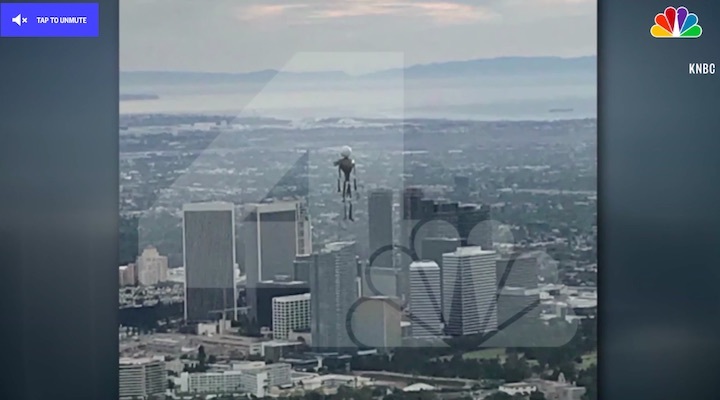2.11.2021
“One working theory is that pilots might have seen balloons,” authorities said.

LOS ANGELES — Authorities investigating a series of possible jetpack sightings over Los Angeles believe they may have identified an explanation for the mysterious reports — one that requires no fuel, no engines, and no high-flying technology.
“One working theory is that pilots might have seen balloons,” the Federal Bureau of Investigation and Federal Aviation Administration said in statements after NBC Los Angeles obtained police video and photos that appear to show a human-shaped inflatable toy floating above Beverly Hills.
The theory gained support after images captured by a Los Angeles Police Department helicopter crew last year showed a human-shaped balloon — believed to be a life-sized Jack Skellington, of Tim Burton’s “A Nightmare Before Christmas” — thousands of feet in the air.
The images showed what could have been a single balloon from a Halloween decoration that broke loose and drifted into the sky.
There have been three sightings over Los Angeles International Airport — one on August 30, 2020, another nearly two months later, on Oct. 14, and a third earlier this year, on July 28.
In all three cases, commercial airline pilots said they saw what appeared to be jetpacks flying at altitudes of 3,000 feet; 6,000 feet; and 5,000 feet.
Officials said Monday that after more than a year of investigation federal agents had been unable to find additional witnesses who saw, or recorded video, of any of the flying objects reported by the pilots either in flight or falling to the ground.
“The FAA has worked closely with the FBI to investigate every reported jetpack sighting,” the FAA said. “So far, none of these sightings have been verified.”
Retired airline pilot and aviation consultant Ross Aimer said Monday the balloon images seem to fit with what the jet pilots reported.
“This now explains that this could possibly be what they saw,” Aimer said.
He said that he believed pilots had made honest reports to air traffic controllers, but at the high relative speed of a jetliner on approach, the flight crews may have only caught a glimpse of the objects.
“There’s a very good possibility the previous ones were also balloons and pilots mistook them as jetpacks,” Aimer said. “This is a better explanation to me and to the aviation community.”
Both the FAA and FBI have said the jetpack inquiry remains an open investigation.
David Mayman, the chief executive of Los Angeles-based Jetpack Aviation, said last year that jetpacks weren’t a plausible explanation. The machines produced by his company — none of which had been sold — only hold a dozen gallons of fuel, or about 10 minutes worth, and couldn’t have reached the altitudes described by the pilots.
“To climb and descend — it takes some time to do that,” he said, adding: “You’d just be out of fuel.”
Mayman’s theory? A battery-powered drone, loaded with an inflatable mannequin and flown remotely.
“Any teen could put this together with parts from China,” he said. “You could be talking about a bright high school kid or college kid — they could build something like this really easily.”
Quelle: NBC News
+++
Anmerkung: Wie schnell auch "geschultes Personal" sich täuschen kann erleben wir hier an der UFO-Meldefront immer wieder, auch wenn dies die Herren Mellon und Elizondo und ihre Fans nicht hören wollen.
H.Köhler/CENAP
